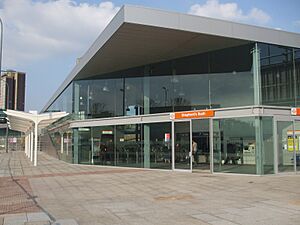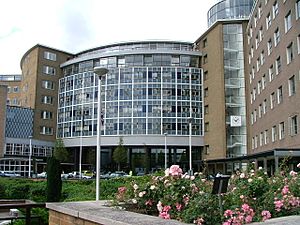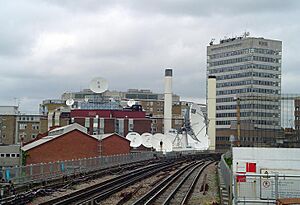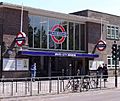White City, London facts for kids
Quick facts for kids White City |
|
|---|---|
| Population | 13,389 (Wormholt and White City Ward 2011) |
| OS grid reference | TQ233807 |
| Ceremonial county | Greater London |
| Region | |
| Country | England |
| Sovereign state | United Kingdom |
| Post town | LONDON |
| Postcode district | W12, W10 |
| Postcode district | NW10 |
| Dialling code | 020 |
| Police | Metropolitan |
| Fire | London |
| Ambulance | London |
| EU Parliament | London |
| UK Parliament |
|
White City is a lively area in London, England. It's located in the western part of the city, within the London Borough of Hammersmith and Fulham. This area is famous for several big landmarks. You'll find Television Centre here, along with White City Place and the huge Westfield London shopping centre. It's also home to Loftus Road, the stadium where the Queens Park Rangers F.C. football team plays. The name "White City" comes from the white marble used on buildings during special exhibitions held here between 1908 and 1914.
Contents
A Look Back: White City's Beginnings
Before 1908, White City was mostly open farmland. But then, it became the exciting location for the Franco-British Exhibition. This big event also hosted the 1908 Summer Olympics! After that, more exhibitions took place, like the Imperial International Exhibition in 1909 and the Japan–British Exhibition in 1910.
The last two exhibitions were the Latin-British Exhibition (1912) and the Anglo-American Exposition (1914). The 1914 event ended early because World War I began. During this time, the area was called the Great White City. This was because many of the exhibition buildings were covered in shiny white marble. That's how this part of Shepherd's Bush got its unique name! In the 1930s, new apartment buildings were built for people to live in.
The Famous White City Stadium
The White City Stadium was a huge sports venue. It was also known as the Great Stadium and could hold 66,000 people! King Edward VII officially opened it on April 27, 1908, for the 1908 Summer Olympics.
The marathon race at the 1908 Olympics started at Windsor Castle. Runners had to cover about 42.195 kilometres (26 miles 385 yards) to reach the finish line at White City Stadium. This exact distance later became the standard for all marathon races around the world!
After the Olympics, the stadium was used for athletics until 1914. Later, it became a track for greyhound racing. It also hosted football games for Queens Park Rangers and other sports. In 1966, it even hosted a football match for the 1966 FIFA World Cup!
In 1934, a famous rodeo promoter named Tex Austin brought the World's Championship Rodeo to the stadium. Cowboys and cowgirls from Canada and the United States showed off their skills. The stadium was also home to the White City Rebels motorcycle speedway team.
The stadium was taken down in 1984. This made way for the new BBC White City building. Today, you can find a list of the 1908 Olympic athletes on the BBC Broadcast Centre Building. The exact spot of the athletics finish line is even marked in the paving outside!
BBC Television Centre and White City Place
In 1960, the famous BBC Television Centre was built where the White City Stadium used to be. This was a major hub for television production.
In 2012, the BBC sold Television Centre. It was then redeveloped, but some of its original cool features were kept. These include the unique "doughnut" building shape and the Helios statue. The redeveloped Television Centre now has entertainment and leisure spots, offices for creative businesses, and about 1,000 new homes. You can also walk through the site, connecting it to nearby areas like Hammersmith Park.
Today, BBC Studioworks operates studios 1, 2, and 3 there. BBC Worldwide also moved into offices in the Stage 6 building.
The area around Television Centre is being transformed into White City Place. This big project will create over 5,000 new homes. It will also add 2 million square feet of office space and 30 acres of public green areas. This development is expected to create 19,000 new jobs!
White City Homes
To provide homes for the growing number of people in Shepherd's Bush, a large housing estate was built. This happened in the late 1930s and after World War II. This estate also took the name White City. The streets there are named after countries that were part of the famous exhibitions.
The estate has its own church, St Michael and St George, built in 1955.
Westfield London: A Shopping Adventure
On October 30, 2008, the massive Westfield London shopping centre opened its doors. It's one of the largest shopping malls in Europe!
In July 2015, a security incident was prevented by police at Westfield London.
Getting Around: Transport Links
White City has excellent transport connections. Two main stations serve the area:
- Wood Lane station is on the Circle line and the Hammersmith & City line. It's also a short walk to the Central line at White City.
- Shepherd's Bush station is on the West London line. It's served by London Overground trains. This station is also close to Shepherd's Bush tube station on the Central line.
Learning in White City: Education
Imperial College London, a top university, bought the BBC Woodlands site in 2009. They built a new campus there, which is like an "innovation hub." This campus includes research facilities and places for new businesses. It also has housing for postgraduate students.
The chemistry department moved much of its research to the new Molecular Sciences Research Hub on this campus in 2018. More departments and companies are expected to move here in the future. The campus also has the Invention Rooms, a place where people can create and learn, and a community outreach centre.
Schools in the White City area include Ark Burlington Danes Academy and Phoenix Academy.
Nearby Places to Explore
- Wormwood Scrubs
- Notting Hill
- Kensal Green
- Bayswater
- Harlesden
- North Kensington
- Acton
- West Kensington
- Shepherd's Bush
Nearest Tube Stations
- East Acton
- Goldhawk Road
- Latimer Road
- Shepherd's Bush Market
- Shepherd's Bush
- White City
- Wood Lane
Nearest Railway Station
- Shepherd's Bush
White City in Books and Movies
- Pete Townshend, a musician who used to live in Shepherd's Bush, released an album called White City: A Novel. This album came with a story that takes place in the White City area of London. A film was also made based on it.
- The Dimco Buildings (built in 1898) are now a bus depot. But they were used as the 'Acme Factory' in the 1988 film Who Framed Roger Rabbit!
- The Bill Slider Novels by Cynthia Harrod-Eagles are set in Shepherd's Bush. The first book, "Orchestrated Death," starts with a body found in a White City flat.
Images for kids














